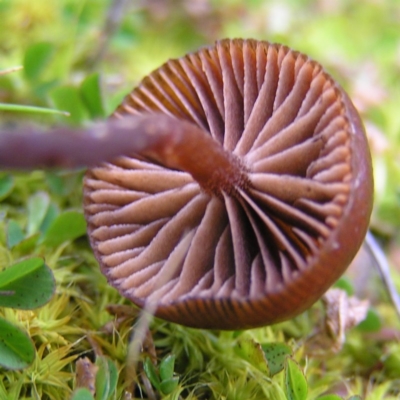Galerina sp.
The fruit body is a mushroom with a stem centrally positioned below the cap. The caps vary in diameter from under a centimetre to 7 centimetres but mostly are between 1 and 3. Cap shape varies from conical to almost flat but mostly you see them gently rounded to hemispherical. Usually there is a small hump at the centre of the cap. Caps are some shade of brown and smooth, sometimes glossy or slightly tacky. Often the margin of the cap is striate. The gills are generally some shade of brown, lighter than that of the cap. Stems are often of some brownish hue, some centimetres long and a few millimetres wide.
A partial veil is present and often this will leave a trace as a ring of tissue around the upper part of the stem, once the cap has fully opened. However, this may be scanty and even disappear early in some cases.
Spore print: rusty brown.
The fruit bodies are found growing from wood or from soil (often bryophyte-covered) in forests, woodlands, city parks and suburban gardens.
In printed or web sources you will often see it said that species of Galerina are found growing amongst mosses. That is true but I often see them surrounded by a pure leafy liverwort colony. It is also common to see printed or web photos, captioned as “Galerina amongst moss” but where the surrounding bryophyte is obviously a liverwort, with numerous characteristic leafy liverwort spore capsules clearly shown.
Galerina sp. is listed in the following regions:
Canberra & Southern Tablelands | Hume
Species information
- Galerina sp. Scientific name
- Common name
- Not Sensitive
- Local native
- Non-invasive or negligible
- Up to 979m Recorded at altitude
- Machine learning








































